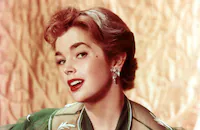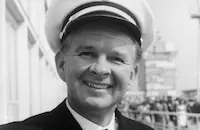Come Fly with Me

Brief Synopsis
Cast & Crew
Henry Levin
Dolores Hart
Hugh O'brian
Karl Boehm
Karl Malden
Pamela Tiffin
Film Details
Technical Specs

Synopsis
During a flight from New York to Paris and Vienna, airline employees and passengers fall in love. Cub stewardess Carol Brewster is attracted to copilot Ray Winsley, 1st-class hostess Donna Stuart is charmed by Austrian Baron Franz von Elzingen, and veteran flight attendant "Bergie" Bergstrom is captivated by Walter Lucas, a shy Texan traveling tourist class. On land, however, the idealistic Carol learns of the copilot's past liaison with married Katy Rimard, materialistic Donna discovers that the baron is a jewel smuggler, and wary Bergie finds her Texan to be a recently bereaved widower. Despite these revelations, the affairs end happily. After Donna pledges fidelity, the baron surrenders to police. Lucas discloses that he is also a millionaire, and escorts Carol and Bergie aboard a chartered jet flown by Ray, intended as a honeymoon express.

Director

Henry Levin
Cast

Dolores Hart
Hugh O'brian

Karl Boehm

Karl Malden

Pamela Tiffin

Lois Nettleton

Dawn Addams

Richard Wattis

Andrew Cruickshank

James Dobson

Lois Maxwell
John Crawford
Robert Easton
Guido Wieland
Maurice Marsac
Bibi Morat
Crew
Pierre Balmain
Philip Barnikel
Albert Becket
Sammy Cahn
Frank Clarke
Bill Creed
Anatole De Grunwald
Jean Dréjac
Felix Evans
Philippe Gérard
Tom Howard
Joan Johnstone
William Kellner
Jimmy Komisarjevsky
Hermann Leopoldi
Oswald Morris
Lyn Murray
Roy Parkinson
William Roberts
Elaine Schreyeck
J. B. Smith
Tom Smith
Wally Stott
Gerry Turner
James Van Heusen
A. W. Watkins
Brian West

Videos
Movie Clip



Trailer
Hosted Intro
Film Details
Technical Specs

Articles
Come Fly With Me
From Sally, Irene and Mary (1925) to Charlie's Angels (2000), Hollywood has mined cinematic gold from stories of female friends on the town and looking for love. Whether the women are trying to figure out How to Marry a Millionaire (1953) or discover Where the Boys Are (1960), the pictures have provided just the right combination of romance, comedy and cheesecake to keep viewers coming back for more.
Bernard Glemser's 1960 novel, Girl on a Wing, was a natural for the movies, with its interlocking stories of five stewardesses and their love lives. The opportunities for international locations fit in with the growing globalization of the American film industry in the early '60s, while the focus on young, beautiful women and the men they pursued offered a natural opportunity for showcasing young talent at MGM, once known for having "more stars than there are in the heavens." But times had changed. The studio had been cutting back on contract talent since the arrival of television in the '50s, and like most of Hollywood was struggling to package films that would pry audiences away from TV.
Producer Anatole de Grunwald was trusted with giving the London-shot film a proper international flair, which he did with location shots of Paris and Vienna. De Grunwald had made his name as a writer-producer whose films had establish the British cinema in the international market. Among his art-house hits were The Winslow Boy (1948) and The Holly and the Ivy (1952). But his new position as an MGM producer, responsible for such all-star pictures as The V.I.P.s (1963) and The Yellow Rolls-Royce (1964), left him little time for writing. Instead, the scripting assignment went to William Roberts, a studio veteran whose biggest success had been the 1960 Western The Magnificent Seven. For director, de Grunwald turned to Henry Levin, who had scored a hit at MGM with the similar-themed Where the Boys Are.
Roberts' script reduced the number of stewardess from five to a more manageable three, providing formulaic roles for three rising actresses (one was smart, one was pretty and one was nice). Dolores Hart, the star of Where the Boys Are, played the smart one who sets her cap for a wealthy Austrian baron (Karlheinz Bohm) only to get caught up in a smuggling ring. Rising young comedienne Pamela Tiffin was the pretty one, so well proportioned she seems about to burst out of her stewardess uniform at any moment. And Lois Nettleton was nice enough to win the heart of a widowed millionaire (Karl Malden).
Far from providing a ticket to stardom, however, Come Fly with Me proved the swan song for Hart. Although considered one of Hollywood's most gifted young actresses, she was unhappy with life in tinsel town and would soon give up the screen to become a nun. Although fan magazines predicted she would come back, she stayed true to her calling and currently serves as Reverend Mother Dolores Hart, prioress of a Connecticut abbey -- and a voting member of the Academy of Motion Picture Arts and Sciences®. Tiffin would give up the screen, too, retiring to marry a wealthy Italian. Only Nettleton has remained active as one of television's most reliable guest stars.
In many ways, Come Fly with Me offers a collection of tantalizing bits, which adds to its cult status. The title was chosen to capitalize on Frank Sinatra's hit recording, but the studio didn't want to pay for his vocal so they had Frankie Avalon record it instead. Hugh O'Brian, who co-stars as a womanizing pilot, has all the ingredients for stardom, including a sense of comic timing reminiscent of Cary Grant's, but he never outgrew his identification with Wyatt Earp, the role that had made him a star on television. Although beloved in his native Austria, where he played the Emperor Franz Josef in four popular films, Bohm never caught on with American audiences. His brief stay at MGM would end with this film though if you've seen him as the homicidal killer in Michael Powell's Peeping Tom (1960), you'll understand why he was never convincing as a conventional romantic lead. Creepy with a capital C!
Cutting the number of leading stewardesses to three reduced the fourth-billed stewardess to a virtual walk-on, although she was played by Lois Maxwell, who was just hitting the big time as Miss Moneypenny in the first James Bond film, Dr. No (1962). At least she had billing, which is more than MGM gave George Coulouris, one of the stars of Citizen Kane (1941), who actually gets more screen time as the customs agent who makes trouble for Hart. Only Malden, an Oscar® winner 12 years earlier for A Streetcar Named Desire (1951), got to show his dramatic mettle in his romantic scenes with Nettleton.
For all the film's failures, however, it maintains a certain charm in light of changing times. The fact that the cheesecake never goes farther than showing Nettleton in a full black slip, and two of the three girls win their men by remaining virgins gives it an appealing innocence. So take the Come Fly with Me challenge. Get together a viewing party. Dress in flight attendant uniforms, preferably a size too small. And every time Hart drops a one-liner or Tiffin falls down or Nettleton cries, take a sip of champagne and kiss your date chastely on the lips.
Producer: Anatole de Grunwald
Director: Henry Levin
Screenplay: William Roberts
Based on the novel Girl on a Wing by Bernard Glemser
Cinematography: Oswald Morris
Art Direction: William Kellner
Music: Lyn Murray
Cast: Dolores Hart (Donna Stuart), Hugh O'Brian (First Officer Ray Winsley), Karlheinz Böhm (Baron Franz Von Elzingen), Pamela Tiffin (Carol Brewster), Lois Nettleton (Hilda 'Bergie' Bergstrom), Dawn Addams (Katie Rinard), Karl Malden (Walter Lucas), Lois Maxwell (Gwen Sandley), Robert Easton (Navigator), George Coulouris (Vienna Police Inspector).
C-109m. Letterboxed. Closed captioning.
by Frank Miller

Come Fly With Me
Quotes
Trivia
Dolores Hart's last movie before becoming a nun.
Notes
Exteriors filmed in Paris, New York City, Vienna, and elsewhere in Austria; interiors in England. Opened in London in April 1963. Working titles: Champagne Flight and The Friendliest Girls in the World. The film acknowledges the cooperation of the authorities of Orly Airport in Paris, Schwechat Airport in Vienna and New York International Airport.

Miscellaneous Notes
Released in United States 1962
Susan George has a bit part in the film.
Released in United States 1962















